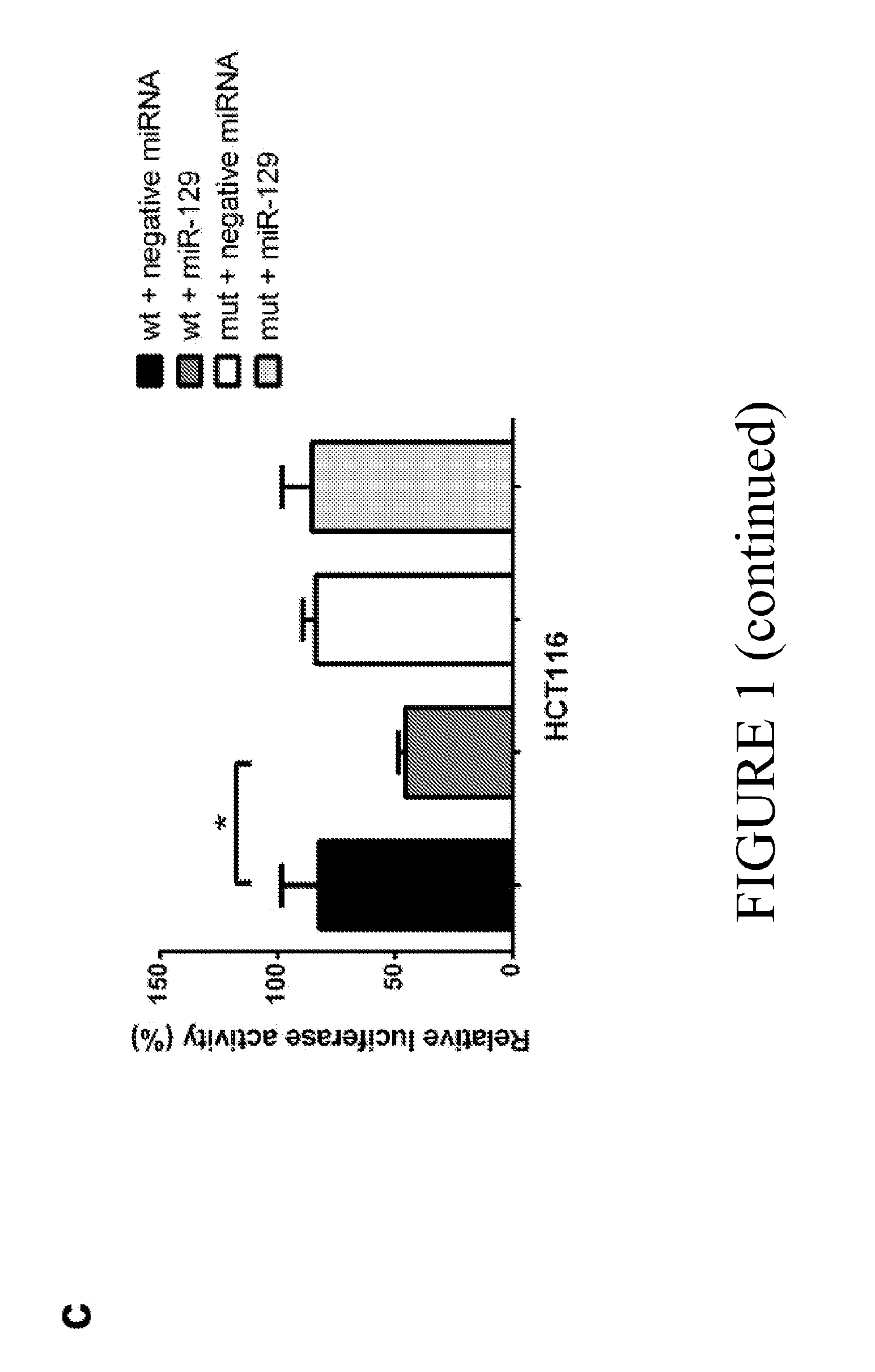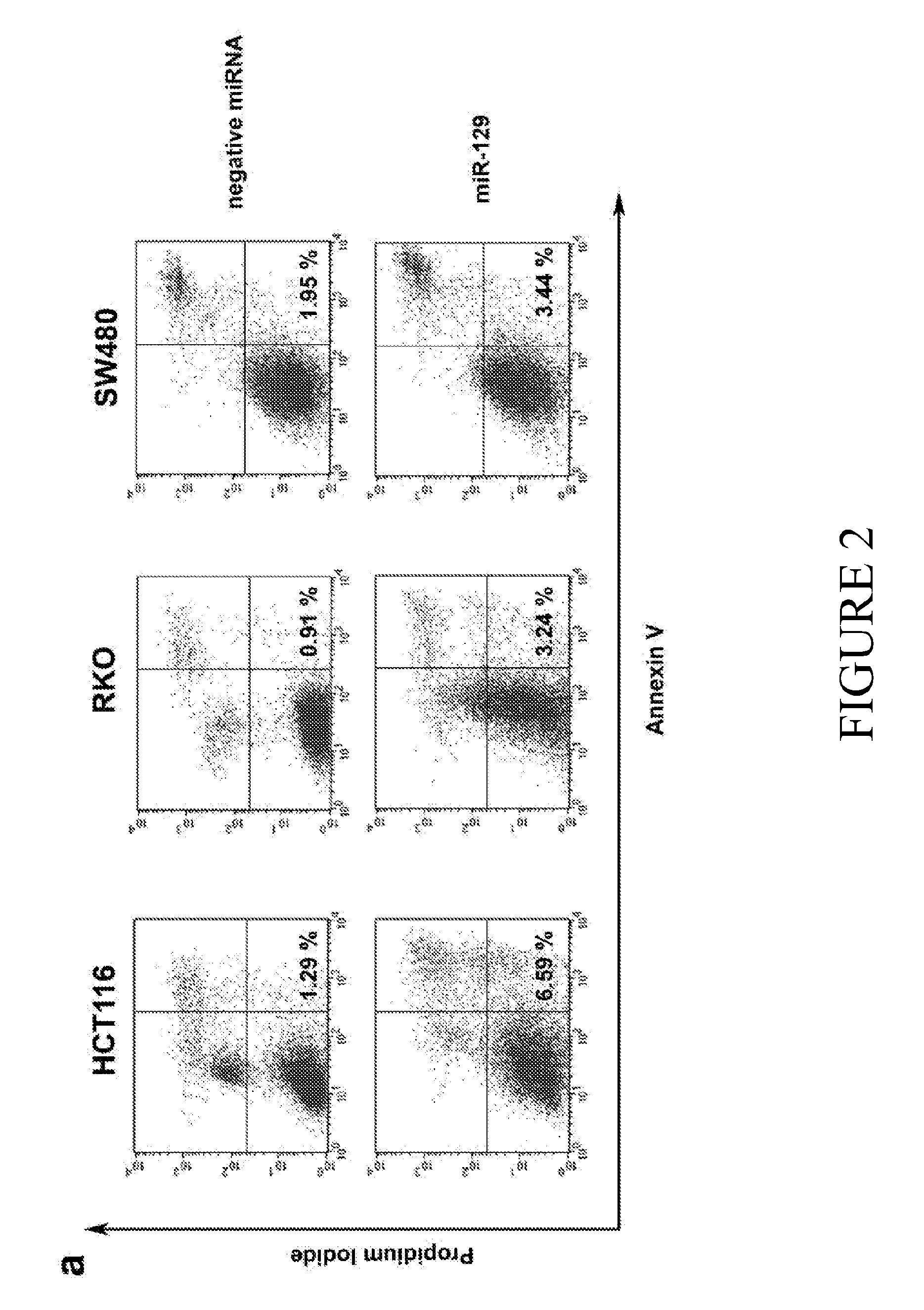MicroRNA-129 AS A BIOMARKER FOR COLORECTAL CANCER
a colorectal cancer and microrna-129 technology, applied in the field of gene identification and gene regulators, can solve the problems of modest response rate of patients to 5-fu-based chemotherapy, and achieve the effects of reducing the expression of e2f3, enhancing the responsiveness of a tumor, and reducing the expression of thymidylate synthase protein levels
- Summary
- Abstract
- Description
- Claims
- Application Information
AI Technical Summary
Benefits of technology
Problems solved by technology
Method used
Image
Examples
example 1
BCL2 is a Direct Target of miR-129 in Colorectal Cancer Cells
[0140]The current disclosure identifies a putative miR-129 binding site, CAAAAA at nucleotide position 1525-1530 in the 3′-UTR of Bcl2 mRNA using TargetScan analysis (FIG. 1a). The controlled expression of BCL2 by miR-129 was demonstrated by the transfection of three colorectal cancer cell lines, HCT116, RICO and SW480 with either negative control miRNA or miR-129 and protein expression of BCL2 was quantified by Western immunoblot analysis. siRNA against BCL2 (siBCL2) was used as a positive control. These data show that miR-129 reduced the BCL2 protein expression in all cell lines tested compared to the negative control miRNA (FIG. 1b). To further confirm the direct interaction between miR-129 and BCL2 mRNA, the miR-129 binding site was cloned from BCL2 mRNA into a luciferase reporter vector (FIG. 1a) and co-transfected with either negative control miRNA or miR-129 into HCT116 cells, and the luciferase activity was measure...
example 2
miR-129 Promotes Apoptosis in Colorectal Cancer Cells
[0142]BCL2 is an anti-apoptotic gene involved in an evolutionarily conserved intrinsic apoptosis pathway. To identify the biological effects of BCL2 repression by miR-129, a FACS analysis was conducted to quantify apoptosis via annexin V and propidium iodide staining. The results show that the presence of miR-129 increased apoptosis significantly in all colorectal cancer cell lines tested, as assessed by the proportion of cells that are annexin V positive and propidium iodide negative (FIGS. 2a and b). Next, it was determined that the increase in apoptosis was due to the activation of the intrinsic apoptosis pathway because the quantified protein expression of cleaved caspase-9 and cleaved caspase-3 by Western immunoblot analysis revealed that, miR-129 elevated the protein levels of both cleaved caspase-9 and -3 (FIG. 2c). These data show that miR-129 functions as a pro-apoptotic molecule by directly targeting BCL2.
example 3
Overexpression of miR-129 Inhibited Colorectal Cancer Cell Growth In Vitro and In Vivo
[0143]The impact of miR-129 on cell proliferation and cell cycle was analyzed by comparing colorectal cancer cells overexpressing miR-129 with control cells not expressing miRNA. Cell proliferation was significantly inhibited in the presence of miR-129 (FIG. 3a). At day 5, the cell proliferation of miR-129 expressing HCT116, RKO and SW480 cells were reduced by 41.2%, 43.9% and 44.7% when compared to the negative controls, respectively. Thus, the overexpression of miR-129 triggered cell cycle arrest in both G1 and / or G2 phase (FIG. 3b). G1 / S and G2 / S ratios indicated that the cell cycle arrest reached significance at G2 checkpoint in HCT116 cells, and at G1 checkpoint in RKO cells (FIG. 3c). Furthermore, FIG. 3d, shows that injection of miR-129 or delivery of miR-129 via viral vector reduces tumor size significantly by directly inhibiting colorectal cancer stem cells in a xenograph mouse model. Thes...
PUM
| Property | Measurement | Unit |
|---|---|---|
| molecular weight | aaaaa | aaaaa |
| molecular weight | aaaaa | aaaaa |
| molecular weight | aaaaa | aaaaa |
Abstract
Description
Claims
Application Information
 Login to View More
Login to View More - R&D
- Intellectual Property
- Life Sciences
- Materials
- Tech Scout
- Unparalleled Data Quality
- Higher Quality Content
- 60% Fewer Hallucinations
Browse by: Latest US Patents, China's latest patents, Technical Efficacy Thesaurus, Application Domain, Technology Topic, Popular Technical Reports.
© 2025 PatSnap. All rights reserved.Legal|Privacy policy|Modern Slavery Act Transparency Statement|Sitemap|About US| Contact US: help@patsnap.com



